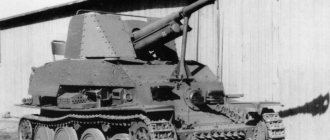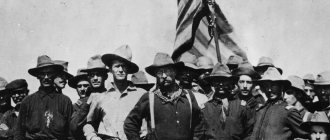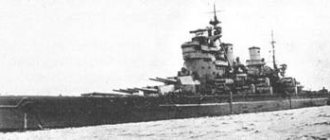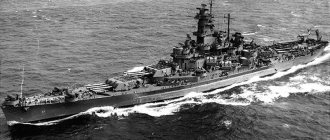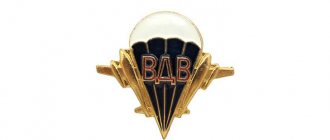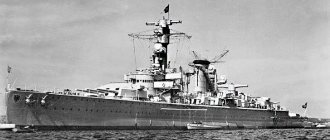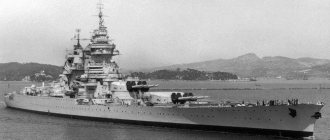Battleships and ironclads | USA
Battleship "Wyoming" (ВВ-32)
Battleship Arkansas (BB-33)
The Wyoming series of battleships consisted of 2 units (Wyoming, Arkansas) and were built at the William Cramp and Sons and New York Shipbuilding Corporation shipyards, respectively. The ships were put into operation in 1912. Arkansas underwent the first modernization in 1925-1928, the second in 1942. Wyoming in 1931-1932. was converted into an artillery training ship. The battleship Wyoming was decommissioned in 1947, and Arkansas was sunk in 1946 while testing nuclear weapons. Performance characteristics of the ship: standard displacement - 26 thousand tons, full displacement - 27.2 thousand tons; length – 171 m, width – 28.4 m; draft – 8.7 m; speed - 20.5 knots; power plants - 4 steam turbine units and 12 steam boilers; power – 28 thousand hp; fuel reserve – 5.1 thousand tons of oil; cruising range - 5.2 thousand miles; crew – 1,060 people. Reservations: side – 280 mm, turrets – 305 mm, barbettes – 280 mm, deck – 88 – 119 mm; casemates - 164 mm, wheelhouse - 292 mm. Armament: 6x2 - 305 mm guns; 16x1 - 127 mm guns; 10x1 – 76 mm guns; 9x4 – 40 mm anti-aircraft guns; 7x4 – 20 mm anti-aircraft guns; catapult and 3 seaplanes.
Battleship New York (BB-34)
Battleship Texas (BB-35)
The series of battleships of the "New York" type consisted of 2 units ("New York", "Texas") and was commissioned in 1914. In 1925-1927. the ships were modernized, and in 1942, anti-aircraft artillery was strengthened. The battleship New York was sunk in 1948, and the Texas has been turned into a museum since 1948. Performance characteristics of the ship: standard displacement - 27 thousand tons, full displacement - 31.9 thousand tons; length – 174 m, width – 32 m; draft – 9.2 m; speed – 20, knots; power plants - 2 steam turbine units and 6 steam boilers; power – 28.1 thousand hp; fuel reserve – 5 thousand tons of oil; cruising range - 7.7 thousand miles; crew – 1,300 people. Reservations: side – 305 mm, turrets – 356 mm, barbettes – 305 mm, deck – 88 – 107 mm; deckhouse – 305 mm. Armament: 5x2 - 356 mm guns; 6x1 - 127 mm guns; 10x1 – 76 mm guns; 6x4 – 40 mm anti-aircraft guns; 36x1 – 20 mm anti-aircraft guns; catapult and 3 seaplanes.
Battleship Nevada (BB-36)
Battleship "Oklahoma" (ВВ-37)
The series of Nevada-class battleships consisted of 2 units (Nevada, Oklahoma) and were built at the Fore River Shipyard and New York Shipbuilding Corporation shipyards, respectively. The ships were put into operation in 1916. In 1927-1930. battleships have undergone modernization. The battleship Nevada underwent a second modernization in 1941 during repairs. The battleship Oklahoma was sunk in 1941, and the Nevada was shot as a target in 1948. Performance characteristics of the ship: standard displacement - 29.7 thousand tons, full displacement - 31.7 thousand tons; length – 178 m, width – 33 m; draft – 9 m; speed - 20.2 knots; power plants - 2 steam turbine units and 6 steam boilers; power – 25 thousand hp; fuel reserve – 2 thousand tons of oil; cruising range - 10 thousand miles; crew – 1,380 people. Reservations: side – 343 mm, traverses – 320 mm, turrets – 457 mm, barbettes – 330 mm, deck – 127 mm; deckhouse – 406 mm. Armament: 2x3 and 2x2 - 356 mm guns; 8x2 – 127 mm anti-aircraft guns; 4x4 – 40 mm anti-aircraft guns; 16x1 – 20 mm anti-aircraft guns; 2 catapults and 2 seaplanes.
Battleship Pennsylvania (BB-38)
Battleship Arizona (BB-39)
The series of battleships of the "Pennsylvania" type consisted of 2 units ("Pennsylvania", "Arizona") and was commissioned in 1916. In 1929-1931. battleships have undergone modernization. The battleship "Arizona" was sunk in 1941, and the "Pennsylvania" was sunk in 1948. Performance characteristics of the ship: standard displacement - 33.4 thousand tons, total displacement - 35.9 thousand tons; length – 185 m, width – 32 m; draft - 9.4 m; speed - 21 knots; power plants - 4 steam turbine units and 12 steam boilers; power – 31.5 thousand hp; fuel reserve – 2.3 thousand tons of oil; cruising range - 6 thousand miles; crew – 1,050 people. Reservations: side – 343 mm, traverses – 320 mm, towers – 457 mm, barbettes – 330 mm, deck – 37 – 114 mm; deckhouse – 406 mm. Armament: 4x3 - 356 mm guns; 12x1 – 127 mm guns; 8x1- 127 mm anti-aircraft guns; 4x1 – 76 mm guns; 10x4 – 40 mm anti-aircraft guns; 22x2 – and 27x1 20-mm anti-aircraft guns; 2 catapults and 2 seaplanes.
Battleship "New Mexico" (ВВ-40)
Battleship "Mississippi" (BB-41)
Battleship "Idaxo" (ВВ-42)
The New Mexico series of battleships consisted of 3 units (New Mexico, Mississippi, Idaho) and were built at the New York Navy Yard, Newport News and New York Shipbuilding Corporation shipyards, respectively. . The ships were put into operation in 1917-1919. In 1931-1934. battleships have undergone modernization. The battleships “New Mexico” and “Idaxo” were decommissioned in 1947, and “Mississippi” - in 1956. Performance characteristics of the ship: standard displacement - 33.4 thousand tons, full displacement - 36.2 thousand tons; length – 190 m, width – 32.4 m; draft - 9.4 m; speed – 22 knots; power plants - 4 steam turbine units and 12 steam boilers; power – 40 thousand hp; fuel reserve – 5.4 thousand tons of oil; cruising range - 5.1 thousand miles; crew – 1,440 people. Reservations: side and traverses – 343 mm, towers – 457 mm, barbettes – 330 mm, deck – 70 – 140 mm; deckhouse – 406 mm. Armament: 4x3 - 356 mm guns; 16x1 – 127 mm guns; 12x4 – 40 mm anti-aircraft guns; 17 - 20 mm anti-aircraft guns; 2 catapults and 2 seaplanes.
Battleship "Tennessee" (BB-43)
Battleship California (BB-44)
The Tennessee-class series of battleships consisted of 2 units (Tennessee, California) and were built at the New York Navy Yard and Mare Island NSY shipyards, respectively. The ships were put into operation in 1920-1921. The battleship Tennessee was modernized in 1942-1943, and California in 1944. In 1947, the ships were withdrawn from service and in 1959 they were scrapped. Performance characteristics of the ship: standard displacement - 32.1 thousand tons, full displacement - 34.6 thousand tons; length – 183 m, width – 30 m; draft - 9.4 m; speed - 21 knots; power plants - 4 turboelectric plants and 8 steam boilers; power – 28.6 thousand hp; fuel reserve – 4.7 thousand tons of oil; cruising range - 9.7 thousand miles; crew – 1,080 people. Reservations: side and traverses – 343 mm, towers – 457 mm, barbettes – 320 mm, deck – 37 – 89 mm; deckhouse – 406 mm. Armament: 4x3 - 356 mm guns; 8x2 – 127 mm guns; 10x4 – 40 mm anti-aircraft guns; 43 - 20-mm anti-aircraft guns; 2 catapults and 3 seaplanes.
Battleship Colorado (BB-45)
Battleship Maryland (BB-46)
Battleship "West Virgnia" (ВВ-48)
The Colorado series of battleships consisted of 3 units (Colorado, Maryland, West Virginia) and were built at the New York Navy Yard and New York Shipbuilding Corporation shipyards. The ships were put into operation in 1921-1923. In 1941-1942. The battleships Colorado and Maryland underwent modernization. "West Virginia" was modernized during the restoration process in 1941-1944. The ships were decommissioned in 1947 and sent for scrapping in 1959. Performance characteristics of the ship: standard displacement - 32.4 thousand tons, full displacement - 34.6 thousand tons; length – 183 m, width – 30 m; draft – 9.5 m; speed - 21 knots; power plants - turboelectric plants and 8 steam boilers; power – 28.9 thousand hp; fuel reserve – 1.9 thousand tons of oil; cruising range - 9.7 thousand miles; crew – 1,080 people. Reservations: side and traverses – 343 mm, towers – 457 mm, barbettes – 320 mm, deck – 37 – 89 mm; deckhouse – 406 mm. Armament: 4x2 - 406 mm guns; 10x1 – 127 mm guns; 8x2 – 127 mm anti-aircraft guns; 10x4 – 40 mm anti-aircraft guns; 43 - 20-mm anti-aircraft guns; 2 catapults and 3 seaplanes.
Battleship North Carolina (BB-55)
Battleship "Wachington" (BB-56)
The North Carolina series of battleships consisted of 2 units (North Carolina, Wachington) and was commissioned in 1941. In 1961, the ships were taken out of service, and the North Carolina was turned into a museum. Performance characteristics of the ship: standard displacement - 37.5 thousand tons, full displacement - 44.4 thousand tons; length – 217 m, width – 33 m; draft – 10 m; speed – 28 knots; power plants - 4 steam turbine units and 8 steam boilers; power – 121 thousand hp; fuel reserve – 6.2 thousand tons of oil; cruising range - 17.5 thousand miles; crew – 1,880 people. Reservation: side – 305 – 168 mm; traverses - 280 mm, towers and barbettes - 406 mm, deck - 37 - 140 mm; deckhouse – 406 mm. Armament: 3x3 - 406 mm guns; 10x2 – 127 mm guns; 15x4 – 40 mm anti-aircraft guns; 8x2 and 63x1 - 20 mm anti-aircraft guns; 2 catapults and 3 seaplanes.
Battleship South Dakota (BB-57)
Battleship Indiana (BB-58)
Battleship "Massachusetts" (BB-59)
Battleship Alabama (BB-60)
The South Dakota series of ships consisted of 4 units (South Dakota, Indiana, Massachusetts, Alabama) and were built at the shipyards of New York Shipbuilding Corporation, Newport News Shipbuilding, Bethlehem Steel Corporation and Norfolk Naval Shipyard "New York Navy Yard" respectively. The ships were commissioned in 1942. The battleships South Dakota and Indiana were decommissioned in 1962 and 1963, and Alabama and Massachusetts in 1964-1965. converted into museums. Performance characteristics of the ship: standard displacement - 38 thousand tons, full displacement - 44.5 thousand tons; length – 203 m, width – 33 m; draft – 10.7 m; speed - 27.5 knots; power plants – 4 steam turbine units and 8 steam boilers; power – 130 thousand hp; fuel reserve – 7 thousand tons of oil; cruising range - 15 thousand miles; crew – 1,800 people. Reservations: belt – 330 mm, traverses – 280 mm, towers – 458 – 242 mm, barbettes – 440 – 287 mm, main deck – 152 – 146 mm, upper deck – 16 – 37 mm, wheelhouse – 406 mm. Armament: 3x3 - 406 mm guns; 10x2 – 127 mm guns; 17x4 – 40 mm anti-aircraft guns; 72x1 - 20 mm anti-aircraft guns; 2 catapults and 3 seaplanes.
Battleship Iowa (BB-61)
Battleship New Jersey (BB-62)
Battleship "Missouri" (BB-63)
Battleship "Wisconsin" (BB-64)
The Iowa series of battleships consisted of 4 units (Iowa, New Jersey, Missouri, Wisconsin) and were built at the NY Navy Yard and Phi Navy Yard shipyards.
The ships were put into operation in 1943 - 1944. Battleships New Jersey, Missouri and Wisconsin in 1999-2001. turned into museums, and "Iowa" is in reserve. Performance characteristics of the ship: standard displacement - 49-49.5 thousand tons, full displacement - 57.5 - 58.1 thousand tons; length – 262 m, width – 33 m; draft – 11 m; speed - 33 knots; power plants – 4 steam turbine units and 8 steam boilers; power – 212 thousand hp; fuel reserve – 7.6 thousand tons of oil; cruising range - 15 thousand miles; crew – 1,900 people. Reservations: belt – 330 mm, traverses – 287 mm, towers – 496-242 mm, barbettes – 440 – 287 mm, main deck – 152 mm, upper deck – 16 – 37 mm, wheelhouse – 445 mm. Armament: 3x3 - 406 mm guns; 10x2 – 127 mm guns; 20x4 – 40 mm anti-aircraft guns; 52x1 - 20 mm anti-aircraft guns; 2 catapults and 3 seaplanes. Share to:
Anti-aircraft weapons
When the battleships entered service, they were equipped with 4 76 mm/50 caliber guns. These guns were quite equivalent to many other guns of the same purpose that had appeared on the battleships of the world by that time. The three-inch anti-aircraft guns fired a projectile weighing 6.8 kg with an initial speed of 823 m/sec; the rate of fire could reach 15-20 rounds/min.
When firing, unitary cartridges were used, with the maximum barrel elevation angle reaching 85 degrees. The maximum firing range (at an angle of 45 degrees) was 13,350 m or 72 cables, the maximum height reach was 9,266 m. These guns, of course, did not have centralized control.
Well-deserved rest
In the 90s, the “Big Four” were finally removed from the lists of the fleet. But this did not stop them from taking human lives. So, in October 1998, one of the hired civilian workers, 61-year-old Arturo Barogna, died on the New Jersey. The poor fellow was hit in the head by a mooring rope that had jumped out of tension and died three hours after the incident.
All the beautiful battleships have become museum ships - today everyone can visit them. One of the “ays”, namely “Missouri”, appeared in Hollywood cinema, and twice as many times. In the films “Under Siege” (although the filming itself took place on one of the battleships of the “South Dakota” type) and “Battleship”, where a World War II veteran famously drowned aliens.
Battleship "Missouri" in the film "Battleship" (2012)
It is interesting that all Iowas have been converted into museums so that it does not damage the ship's systems. That is, in an emergency situation, such as an alien attack, they can be put into operation relatively quickly. And then the mighty 406 mm guns will speak again.
Japan
Who built the largest and most modern battleships of World War II? Japan. "Yamato" and the second ship of the series, which became the last, "Musashi", had a titanic displacement (full) exceeding 70 thousand tons. These giants were and were armed with the most powerful main caliber guns of 460 mm. The armor also had no equal - from 400 to 650 mm. To destroy such a monster, dozens of direct hits from torpedoes, aerial bombs or artillery shells were required. The Americans found all these lethal weapons in sufficient quantities, and the circumstances were such that they were able to use them. They were angry at the Japanese for Pearl Harbor and had no pity.
How many were there in total?
Over the entire period called pre-war (in fact, the war was already underway, in Spain and the Far East, for example), and all the years of the “hot phase” of the world conflict, the most developed countries, seeking to establish or restore their regional (or world) dominance, built twenty seven units of ships belonging to the class of battleships.
The Americans launched the most, as many as ten. This testifies to the very serious intentions of the United States to maintain the level of its influence in remote areas of the World Ocean, however, without large-scale direct participation of ground forces, which at that time were quite modest.
Britain takes second place with its five units. Good too.
Germany, having just rejected the terms of Versailles, launched four.
Italy, which during the reign of Duce Mussolini claimed the role of a regional Mediterranean leader, was able to master three large-tonnage units. France managed to produce the same number of dreadnoughts.
Japanese battleships of the Second World War are represented by two units of the Yamato series. Relatively compared to other members of the “club,” the imperial fleet was going to compensate for the small number with the cyclopean size of the ships.
The figures given are actual. The plans were much more extensive.
The state of naval tactical thought in the interwar period
Since the Anglo-Dutch naval battles raged on the seas until the middle of the 20th century, the idea of an ideal ship existed and practically did not change in the minds of the command of fleets around the world. The main tactical technique was formed at the same time, in the 17th century, and it consisted of lining up all forces in a wake column, and then opening fire from all barrels. Whoever sinks the most enemy units wins. The Battle of Jutland in 1916, which took place according to a slightly different scenario, brought some confusion into the minds of naval commanders. Carrying out vigorous maneuvering, the German squadron inflicted significant damage on the British forces, which had quantitative and qualitative superiority, suffering half as many losses and “beating on points” (in sports terminology) the enemy. However, the British also hastened to announce the victorious outcome of the battle, without bothering to analyze their generally unsuccessful actions. But you should have thought about it. Perhaps then the battleships of World War II would have been a more effective weapon in the fight against fascism, or at least there would have been fewer of them, freeing up resources for other, more important defense programs. However, the winners of Jutland, the Germans, did not draw the right conclusions either. They (at least Hitler and his immediate circle) also considered power and size to be a priority factor in defeating the enemy. And other countries that faced heavy battles on the seas and oceans held similar views. They were all wrong.
Big clubs
After the war, it was expensive to maintain a huge fleet, and cutting four new battleships into metal was a pity. Most of them were mothballed - only one Missouri remained in service.
On January 17, 1950, the victor of Tokyo Bay ran aground, and so recklessly that the hull was severely deformed. To restore it completely meant disassembling the battleship in half and reassembling it again - it was long and expensive. Therefore, the Americans limited themselves to “cosmetic” repairs of the outer skin, applied along the deformed contours of the hull. The irony of fate was that the speed of the battleship, built for speed, was now limited to some 24 knots.
Battleship Missouri landing on a sandbar
The second half of the 20th century became a series of conservations, re-conservations and military conflicts for the Iowas. They served in Korea, Vietnam, Lebanon and the First Iraq Campaign. The tasks were always the same - artillery support and impact on coastal communications. The Iowas produced as much steel and explosives in 30 minutes as the air wing of a large aircraft carrier did in a whole day, and they did it cheaper.
There were, of course, features - range, accuracy, ratio of explosives to metal. But the point in using battleships still remained - otherwise they would not have been pulled out of conservation every time another more or less serious war broke out somewhere on the edge of the globe with the participation of Americans.
Why didn't the plans come true?
The battleship "Soviet Union" of project "A" was laid down in Leningrad by plant No. 15 in the summer of 1938, two units ("Soviet Belarus", "Soviet Russia") began to be built in Molotovsk (today this city is called Severodvinsk), another one - in Nikolaev (“Soviet Ukraine”). So it is impossible to blame I.V. Stalin for projectism and manilovism; the plans set by the party were carried out steadily. Another question is that there were objective difficulties, for which, quite possibly, some comrades who failed to complete the task were subjectively responsible before the law. At the time of the German attack, the ships under construction were in varying degrees of readiness, but no more than a fifth of the total volume of work. The most modern battleships of the USSR of the Second World War never entered combat service, serving as donors for other important defense programs. Their guns and armor plates were used, but they themselves never went to sea. There was not enough time and experience; developing the technology took too long.


